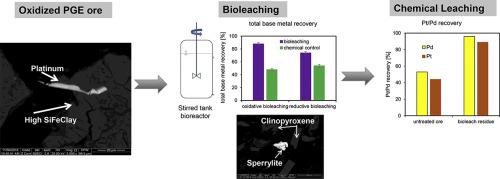当前位置:
X-MOL 学术
›
Hydrometallurgy
›
论文详情
Our official English website, www.x-mol.net, welcomes your feedback! (Note: you will need to create a separate account there.)
Bioprocessing of oxidized platinum group element (PGE) ores as pre-treatment for efficient chemical extraction of PGE
Hydrometallurgy ( IF 4.7 ) Pub Date : 2020-09-01 , DOI: 10.1016/j.hydromet.2020.105419 Sabrina Hedrich , Dennis Kraemer , Malte Junge , Herwig Marbler , Michael Bau , Axel Schippers
Hydrometallurgy ( IF 4.7 ) Pub Date : 2020-09-01 , DOI: 10.1016/j.hydromet.2020.105419 Sabrina Hedrich , Dennis Kraemer , Malte Junge , Herwig Marbler , Michael Bau , Axel Schippers

|
Abstract Platinum-group elements (PGE) are relevant for many high technology applications, prompting the search for potential alternative resources and environmentally friendly processing technologies. The largest deposit of PGE worldwide is the Bushveld Complex in South Africa. The pristine sulfide-bearing ore is mined using conventional metallurgical methods, while the near-surface oxidized PGE ore is currently stockpiled. Economic extraction of PGE from these stockpiles using conventional technologies is not feasible to date. Hence, biohydrometallurgical approaches to recover valuable transition metals and liberate platinum-group minerals for subsequent chemical PGE extraction have been considered. The four stockpile samples taken from a heap of oxidized PGE ores from the Platreef formation showed a similar mineralogical composition with >90 wt% silicates and minor amounts of Fe-(oxy)/hydroxides, both associated with Ni, Mn and Cu. Platinum-group minerals were present as sperrylite (PtAs2), cooperite (PtS low Pd), native platinum and Pd‑bismuthotellurides and mostly associated with silicates. Stirred tank bioleaching under various conditions was proven to be most feasible for an oxidative process at moderately-high temperatures using a consortium of iron- and sulfur-oxidizing acidophiles dominated by Acidithiobacillus caldus and Sulfobacillus thermosulfidooxidans. Bioleaching achieved up to 86% total metal recovery (including Co, Cu, Mn and Ni) and led to a liberation of platinum-group minerals. The bioleach residues were subsequently chemically leached by a HNO3/NaCl and a cyanide leach, allowing for the enhanced extraction of up to 89% Pt and 96% Pd after bioleaching. Chemical and mineralogical analysis validated the potential of oxidative bioleaching as a promising processing option for a pre-treatment of oxidized PGE ore, allowing separate and efficient recovery of valuable base metals and enhancing the subsequent chemical PGE extraction.
中文翻译:

氧化铂族元素 (PGE) 矿石的生物处理作为有效化学提取 PGE 的预处理
摘要 铂族元素 (PGE) 与许多高科技应用相关,促使人们寻找潜在的替代资源和环保加工技术。世界上最大的铂族金属矿床是南非的布什维尔德矿床。原始的含硫化物矿石是使用常规冶金方法开采的,而近地表氧化的 PGE 矿石目前正在储存。迄今为止,使用传统技术从这些库存中经济提取 PGE 是不可行的。因此,已经考虑采用生物湿法冶金方法来回收有价值的过渡金属并释放铂族矿物用于后续的化学 PGE 提取。从 Platreef 地层的氧化 PGE 矿石堆中采集的四个库存样品显示出相似的矿物组成,> 90 wt% 的硅酸盐和少量的 Fe-(氧)/氢氧化物,均与 Ni、Mn 和 Cu 相关。铂族矿物以闪锌矿 (PtAs2)、铜钴矿(PtS 低 Pd)、天然铂和 Pd-bismuthotellurides 形式存在,并且主要与硅酸盐伴生。事实证明,在中等高温下,使用以酸性硫杆菌和热硫化氧化硫杆菌为主的铁和硫氧化嗜酸菌的联合体,在各种条件下搅拌罐生物浸出是最可行的。生物浸出实现了高达 86% 的总金属回收率(包括 Co、Cu、Mn 和 Ni),并释放了铂族矿物。生物浸出残留物随后通过 HNO3/NaCl 和氰化物浸出进行化学浸出,允许在生物浸出后提高高达 89% 的 Pt 和 96% 的 Pd 的提取。
更新日期:2020-09-01
中文翻译:

氧化铂族元素 (PGE) 矿石的生物处理作为有效化学提取 PGE 的预处理
摘要 铂族元素 (PGE) 与许多高科技应用相关,促使人们寻找潜在的替代资源和环保加工技术。世界上最大的铂族金属矿床是南非的布什维尔德矿床。原始的含硫化物矿石是使用常规冶金方法开采的,而近地表氧化的 PGE 矿石目前正在储存。迄今为止,使用传统技术从这些库存中经济提取 PGE 是不可行的。因此,已经考虑采用生物湿法冶金方法来回收有价值的过渡金属并释放铂族矿物用于后续的化学 PGE 提取。从 Platreef 地层的氧化 PGE 矿石堆中采集的四个库存样品显示出相似的矿物组成,> 90 wt% 的硅酸盐和少量的 Fe-(氧)/氢氧化物,均与 Ni、Mn 和 Cu 相关。铂族矿物以闪锌矿 (PtAs2)、铜钴矿(PtS 低 Pd)、天然铂和 Pd-bismuthotellurides 形式存在,并且主要与硅酸盐伴生。事实证明,在中等高温下,使用以酸性硫杆菌和热硫化氧化硫杆菌为主的铁和硫氧化嗜酸菌的联合体,在各种条件下搅拌罐生物浸出是最可行的。生物浸出实现了高达 86% 的总金属回收率(包括 Co、Cu、Mn 和 Ni),并释放了铂族矿物。生物浸出残留物随后通过 HNO3/NaCl 和氰化物浸出进行化学浸出,允许在生物浸出后提高高达 89% 的 Pt 和 96% 的 Pd 的提取。


























 京公网安备 11010802027423号
京公网安备 11010802027423号